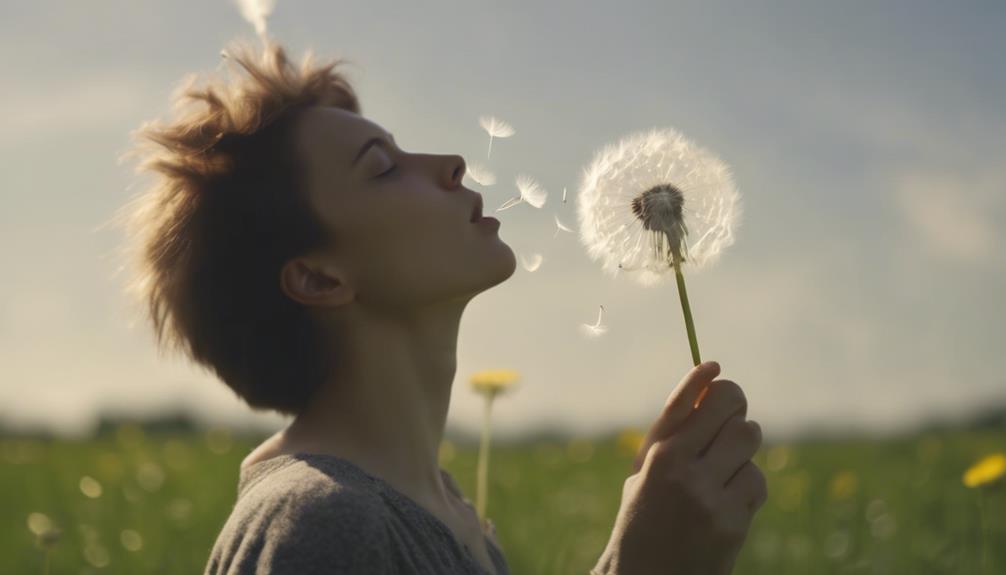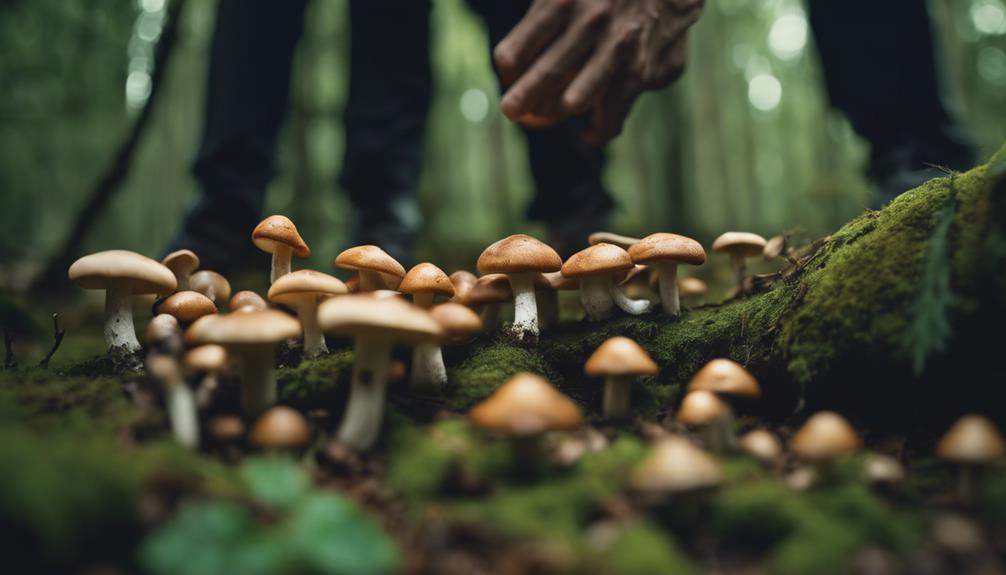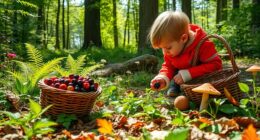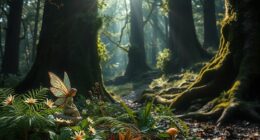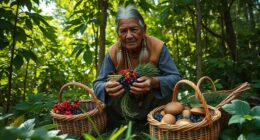Discover the secrets of expert mushroom hunters who have a deep understanding of the special connection between morel mushrooms and specific tree companions such as cherry, tulip, and white pines. The key to success lies in correctly identifying these mushrooms. Gain insight into how weather variations, spring showers, and controlled burns influence the growth of morels, resulting in a progression from blacks to half-frees and whites. Arm yourself with necessary tools like a knife, basket, and field guide to elevate your foraging experience. Venture into wooded areas with controlled burns, where morels thrive. Experienced foragers offer valuable tips and tactics, unveiling hidden treasures in the world of mushroom hunting.
Key Takeaways
- Learn tree associations for morels: cherry, tulip, pine, poplar.
- Understand weather impact on morel growth: temperature, rainfall.
- Equip with tools: knife, basket, field guide, compass, whistle.
- Hunt in forest burn sites for morel success.
- Join organized hunts for insights and strategies from experts.
Habitat Dependence of Morel Mushrooms
Morel mushrooms thrive in symbiotic relationships with specific tree species like cherry trees, tulip trees, white pines, and poplar trees in their habitat. When foraging for these prized fungi, understanding their habitat dependence is essential. Proper mushroom identification, knowing the trees they associate with, is key to a successful hunt.
Morels come in three main species: whites, blacks, and half-frees. Their appearance order typically follows a sequence starting with blacks, then half-frees, and finally whites. By recognizing the trees that morels favor, such as the cherry, tulip, white pine, and poplar, you can narrow down potential foraging locations. These mushrooms rely on these trees for nutrients and create a mutually beneficial relationship.
Weather conditions, such as spring rainfall and ecological burns, play a significant role in influencing the growth and visibility of morel mushrooms. Understanding the habitat preferences of morels and the environmental factors that impact their growth can enhance your foraging success.
Symbiotic Tree Relationships

Certain mushrooms like morels form mutually beneficial relationships with specific tree species like cherry, tulip, white pines, and poplar trees.
These symbiotic partnerships play an essential role in the woodland ecosystem, fostering connections between tree fungi and creating a harmonious environment for mushroom growth.
Understanding these intricate tree relationships can greatly enhance your success in foraging for these elusive fungi.
Tree Fungi Connections
Fungi establish symbiotic relationships with trees through mycorrhizal networks, facilitating essential nutrient exchange and enhancing overall ecosystem health. These connections between trees and fungi are pivotal for maintaining the vitality of forests. Here's how this fascinating relationship works:
- Mycelial threads of fungi connect trees, forming a complex underground communication system.
- Trees provide sugars to fungi, while fungi enhance tree resilience and nutrient absorption.
- Fungi assist in tree defense mechanisms against pathogens and environmental stressors.
As mushroom hunters, understanding the intricate web of mycorrhizal networks allows you to appreciate the interconnectedness of the woodland ecosystem.
Woodland Ecosystem Partnerships
Understanding the symbiotic partnerships between trees and fungi in the woodland ecosystem is essential for enhancing forest health and ecosystem sustainability. Trees and fungi engage in intricate relationships through mycorrhizal networks, where fungi aid in nutrient exchange and communication among trees. This partnership is critical for the overall well-being of the woodland ecosystem, as it supports tree growth and enhances nutrient uptake. Trees provide sugars to fungi, while fungi assist trees in absorbing water and essential nutrients. By breaking down organic matter, fungi play an important role in recycling nutrients and facilitating healthy ecosystem dynamics.
To emphasize the importance of these partnerships, let's take a closer look at the key roles played by trees and fungi in the woodland ecosystem:
| Trees | Fungi | Ecosystem Health |
|---|---|---|
| Provide sugars | Aid in nutrient exchange | Enhance forest sustainability |
| Absorb water and nutrients | Facilitate communication among trees | Support tree growth |
| Essential for ecosystem dynamics | Break down organic matter | Improve nutrient uptake |
Weather's Impact on Morel Hunting
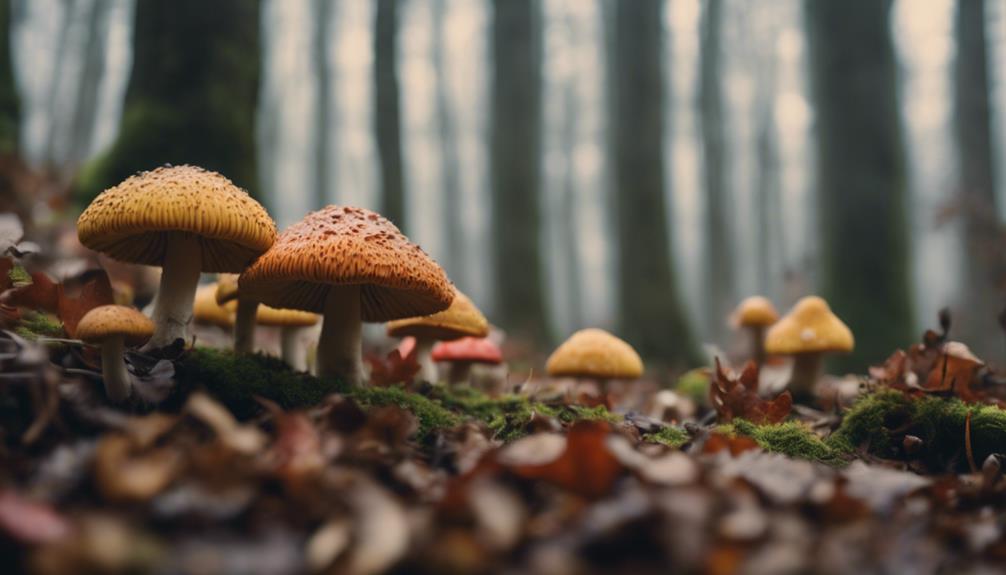
Early spring temperatures and rainfall play essential roles in morel hunting, influencing the growth and visibility of these sought-after mushrooms.
Once temperatures climb towards the upper 70s to 80s, the morel season typically draws to a close.
Understanding how rain and temperature impact morel growth can greatly enhance your hunting success in the wild.
Rain's Role in Hunting
Rainfall in the spring season plays a significant role in influencing the growth and appearance of morel mushrooms, impacting the success of your hunting expeditions.
When it rains, morel mushrooms tend to flourish, making it an ideal time to head out into the wild in search of these prized fungi.
Here are some key points to keep in mind regarding rain's role in hunting:
- Moisture Matters: Morel mushrooms thrive in moist environments, so a good rainfall can trigger their growth and make them more visible in their natural habitat.
- Timing Is Key: Monitor the weather closely, as a well-timed rain shower can signal the beginning of morel season, prompting the mushrooms to emerge from the forest floor.
- Post-Rain Strategy: After a rainy day, head out to hunt the following day for the best chances of spotting morel mushrooms at their peak freshness and abundance.
Temperature's Influence on Finds
The temperature plays a vital role in determining the success of your morel mushroom hunting expeditions, affecting the growth and visibility of these prized fungi. Understanding the temperature's influence is essential for morel hunting enthusiasts.
Morel hunting is weather-dependent, with the season starting in early spring and ending as temperatures hit the upper 70s to 80s. Rainfall during spring significantly impacts morel mushroom growth, making them more visible.
Ecological burns are essential in increasing morel abundance and visibility for hunters. Monitoring weather patterns and temperatures can help predict the best times for morel mushroom hunting excursions.
Essential Tools for Foragers
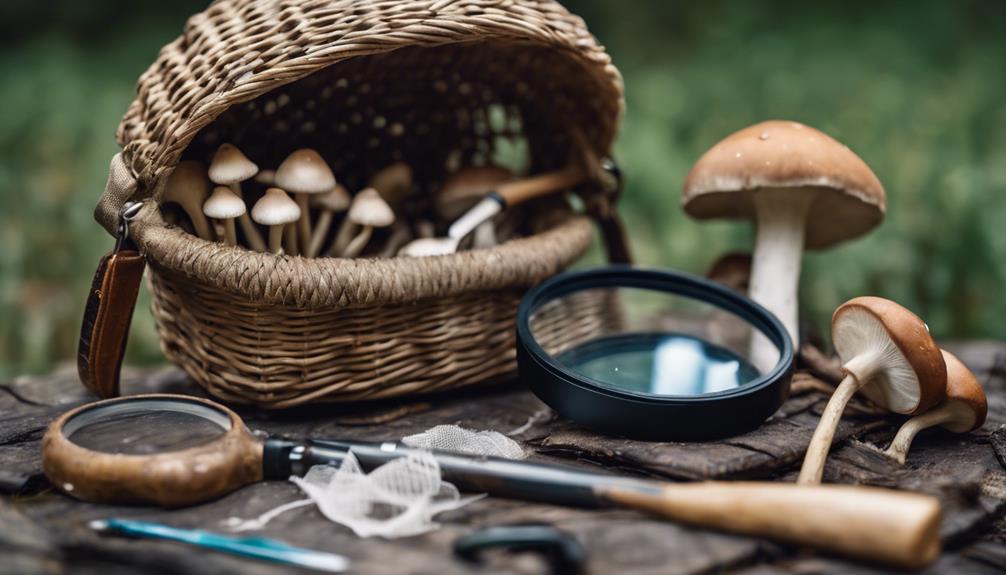
To become a successful mushroom forager, you need essential tools that include a knife for harvesting, a basket or bag for collecting, a field guide for identification, a magnifying glass for closer inspection, and a compass for navigation in the wilderness. Carrying a whistle for safety, a water bottle for hydration, and a walking stick for stability can further enhance your foraging experience. Additionally, using a fishing creel or mesh bag allows collected mushrooms to breathe and release spores efficiently.
When out foraging for mushrooms, a field guide is invaluable for identifying different species and distinguishing them from potentially harmful lookalikes. The guidebook provides essential information on the identifying features of mushrooms, their habitats, and characteristics that differentiate them from poisonous counterparts.
Equipped with the proper tools and knowledge, you can navigate the forest confidently, harvest sustainably, and enjoy a successful foraging expedition.
Hunting in Forested Areas
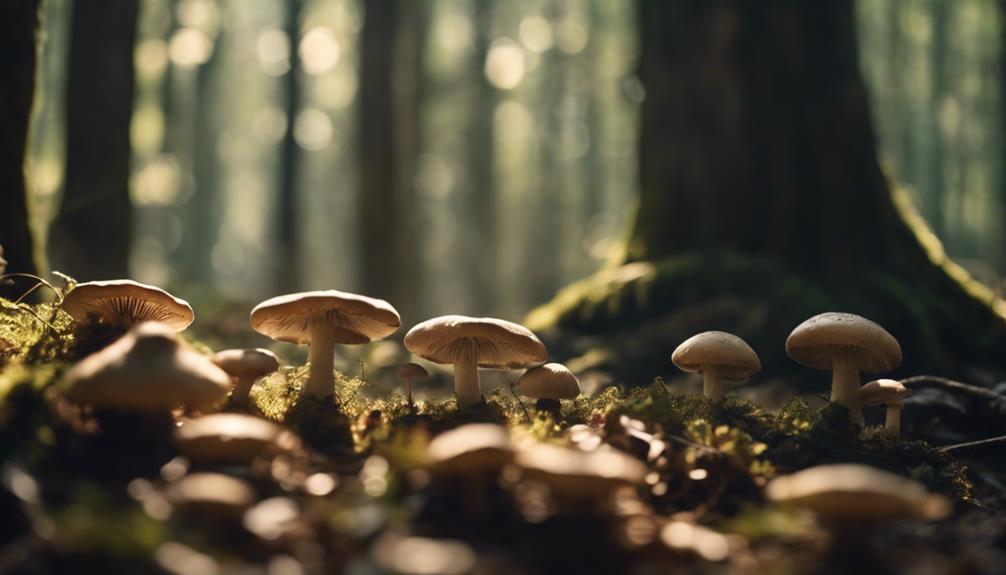
Exploring forested areas with large prescribed burn sites can greatly enhance your chances of successful morel mushroom hunting. Morel mushrooms, known for their unique honeycomb appearance and earthy flavor, thrive in these environments due to their symbiotic relationship with specific trees like white pines and poplar trees.
When hunting for morels in forested regions, keep in mind that white morels are often found near cherry trees and tulip trees, while black morels prefer certain tree species. Additionally, morel mushrooms tend to appear in a specific order during the season in forested areas: blacks, followed by half-frees, and then whites.
Factors such as rainfall and ecological burns also play an important role in influencing the growth and visibility of morel mushrooms in forested locations. By understanding the relationship between morels and their environment, you can strategically plan your mushroom hunting expeditions in forested areas with prescribed burn sites to maximize your chances of a successful foraging experience.
Maximizing Burn Site Opportunities

Consider joining organized hunts with experienced foragers to maximize your opportunities for morel mushroom hunting in burn sites. These seasoned foragers can provide valuable insights and guidance, increasing your chances of finding these elusive edible mushrooms in the aftermath of prescribed burns.
Remember, morel mushrooms are more likely to flourish in forested areas with extensive burn sites, offering prime locations for foragers to explore. When searching for mushrooms in burn sites, focus on wooded areas rather than grassy patches, where morels are less likely to be found.
Additionally, utilizing tools like a fishing creel, knife, compass, magnifying glass, whistle, water bottle, and walking stick can enhance your experience by aiding in navigation and mushroom collection. By taking advantage of organized hunts and employing the right tools and strategies, you can make the most of burn sites and uncover the secrets these areas hold for mushroom foragers.
Frequently Asked Questions
What Is the Saying About Mushroom Forager?
Be cautious when foraging for mushrooms. Remember the saying: 'All mushrooms are edible, but some only once.' Don't take risks with unidentified fungi. Always be certain of a mushroom's safety before eating it.
How to Find the Mushroom Guy in Sneaky Sasquatch?
To find the Mushroom Guy in Sneaky Sasquatch, head to the forest near the ranger's station. Keep checking back regularly since he appears randomly. Interact with him to receive quests and rewards that enhance your gameplay.
How to Start Mushroom Foraging in Sneaky Sasquatch?
So you wanna explore mushroom foraging in Sneaky Sasquatch, huh? Well, it's simple! Just head into the forest, keep your eyes peeled for those little fungi treasures, and start collecting like a pro!
Where Is the Prince Mushroom in Sneaky Sasquatch?
You'll find the Prince Mushroom in Sneaky Sasquatch in the forest near the campsite. Keep searching for its distinctive purple color. It's a rare and valuable item that appears randomly, so be patient and observant!
Conclusion
Now that you have uncovered the secrets of master mushroom foragers, it's time to put your newfound knowledge to the test. Remember, patience and persistence are key when hunting for morel mushrooms.
The thrill of the hunt and the satisfaction of finding these elusive fungi await you in the forest. So grab your tools, head out into the wild, and let the adventure begin.
Happy foraging!




